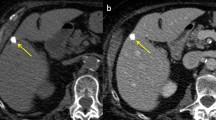Abstract
Objective
To investigate the value of computed tomography (CT) perfusion imaging for assessment of angiogenesis in liver cancer.
Methods
Twenty-one patients with histologically proven liver cancer underwent CT perfusion examination. We compared the following perfusion parameters in the tumour area versus the non-tumour area: total blood flow (TBF), hepatic arterial perfusion (HAP), hepatic portal perfusion (HPP) and hepatic arterial perfusion index (HAPI). Slices of postoperative specimen were stained with haematoxylin–eosin and anti-CD34 immunohistochemistry. The slices were evaluated with emphasis on the CD34-positive neovasculature in the tumour parenchyma. Tumour microvascular density (MVD) was calculated according to the Weidner method. Pearson correlation was used to detect correlations between tumour MVD and tumour perfusion parameters.
Result
TBF and HPP in the tumour area were lower than in the non-tumour area (P < 0.05). HAP and HAPI in the tumour area were higher than those of the non-tumour area (P < 0.05). TBF and HAP in the tumour area correlated with MVD in the tumour (P < 0.05), with correlation coefficients of 0.849 and 0.829, respectively.
Conclusion
CT perfusion imaging can quantitatively assess the blood supply and its distribution in liver cancer. TBF or HAP may be a useful parameter in assessing angiogenesis of liver cancer.


Similar content being viewed by others
References
Palma LD (1998) Diagnostic imaging and interventional therapy of hepatocellular carcinoma. Br J Radiol 71:808–818
Fontanini G, Lucchi M, Vignati S, Mussi A, Ciardiello F, De Laurentiis M, De Placido S, Basolo F, Angeletti CA, Bevilacqua G (1997) Angiogenesis as a prognostic indicator of survival in non-small-cell lung carcinoma: a prospective study. J Natl Cancer Inst 89:881–886
Padhani AR (1999) Dynamic contrast-enhanced MRI studies in human tumors. Br J Radiol 72:427–431
Miles KA, Leggett DA, Kelley BB, Hayball MP, Sinnatamby R, Bunce I (1998) In vivo assessment of neovascularization of liver metastases using perfusion CT. Br J Radiol 71:276–281
Folkman J (1990) What is the evidence that tumors are angiogenesis dependent? J Natl Cancer Inst 82:4–6
Fidler IJ, Ellis LM (1994) The implications of angiogenesis for the biology and therapy of cancer metastasis. Cell 79:185–188
Lee TY, Purdie TG, Stewart E (2003) CT imaging of angiogenesis. Q J Nucl Med 47:171–187
Miles KA (2002) Functional computed tomography in oncology. Eur J Cancer 38:2079–2084
Miles KA, Griffiths MR (2003) Perfusion CT: a worthwhile enhancement? Br J Radiol 76:220–231
Miles KA, Hayball MP, Dixon AK (1993) Functional images of hepatic perfusion obtained with dynamic CT. Radiology 188:405–411
Tsushima Y, Blomley JK, Kusano S, Endo K (1999) The portal component of hepatic perfusion measured by dynamic CT: an indicator of hepatic parenchymal damage. Dig Dis Sci 44:1632–1638
Weidekamm C, Cejna M, Kramer L, Peck-Radosavljevic M, Bader TR (2005) Effects of TIPS on liver perfusion measured by dynamic CT. AJR Am J Roentgenol 184:505–510
Fuentes MA, Keith CJ, Griffiths M, Durbridge G, Miles KA (2002) Hepatic haemodynamics: interrelationships between contrast enhancement and perfusion on CT and Doppler perfusion indices. Br J Radiol 75:17–23
Weidner N (1995) Current pathologic methods for measuring intratumoral microvessel density within breast carcinoma and other solid tumors. Breast Cancer Res Treat 36:169–180
Pluda JM (1997) Tumor-associated angiogenesis: mechanisms, clinical implications, and therapeutic strategies. Semin Oncol 24:203–218
Miles KA (2003) Perfusion CT for the assessment of tumour vascularity: which protocol? Br J Radiol 76(Spec No 1):S36–S42
Cenic A, Nabavi DG, Craen RA, Gelb AW, Lee TY (1999) Dynamic CT measurement of cerebral blood flow: a validation study. AJNR Am J Neuroradiol 20:63–73
Gillard JH, Antoun NM, Burnet NG, Pickard JD (2001) Reproducibility of quantitative CT perfusion imaging. Br J Radiol 74:552–555
Pandharipande PV, Krinsky GA, Rusinek H, lee VS (2005) Perfusion imaging of the liver: current challenges and future goals. Radiology 234:661–673
Craft PS, Harris AL (1994) Clinical prognostic significance of tumour angiogenesis. Ann Oncol 5:305–311
Stavropoulos NE, Bouropoulos C, Ioachim IE, Michael M, Hastazeris K, Tsimaris I, Kalogeras D, Liamis Z, Stefanaki S, Agnantis NI (2004) Prognostic significance of angiogenesis in superficial bladder cancer. Int Urol Nephrol 36:163–167
Canoğlu A, Göğüş C, Bedük Y, Orhan D, Tulunay O, Baltaci S (2004) Microvessel density as a prognostic marker in bladder carcinoma: correlation with tumor grade, stage and prognosis. Int Urol Nephrol 36:401–405
Sahani DV, Holalkere NS, Mueller PR, Zhu AX (2007) Advanced hepatocellular carcinoma: CT perfusion of liver and tumor tissue-initial experience. Radiology 243:736–743
Leggett DA, Kelley BB, Bunce IH, Miles KA (1997) Colorectal cancer: diagnostic potential of CT measurements of hepatic perfusion and implications for contrast enhancement protocols. Radiology 205:716–720
Acknowledgments
This work was funded by the National Natural Science Foundation of China (project number C30500138)
Author information
Authors and Affiliations
Corresponding author
Rights and permissions
About this article
Cite this article
Yang, H.F., Du, Y., Ni, J.X. et al. Perfusion computed tomography evaluation of angiogenesis in liver cancer. Eur Radiol 20, 1424–1430 (2010). https://doi.org/10.1007/s00330-009-1693-y
Received:
Revised:
Accepted:
Published:
Issue Date:
DOI: https://doi.org/10.1007/s00330-009-1693-y




